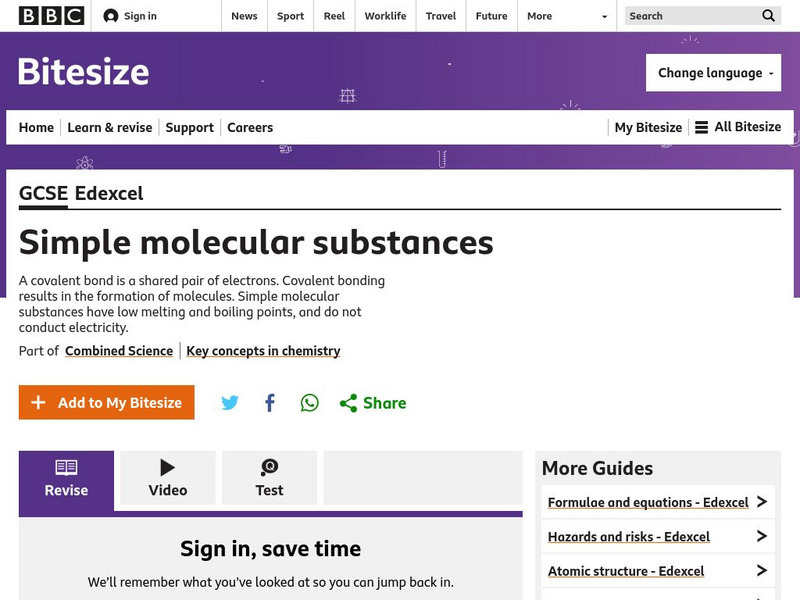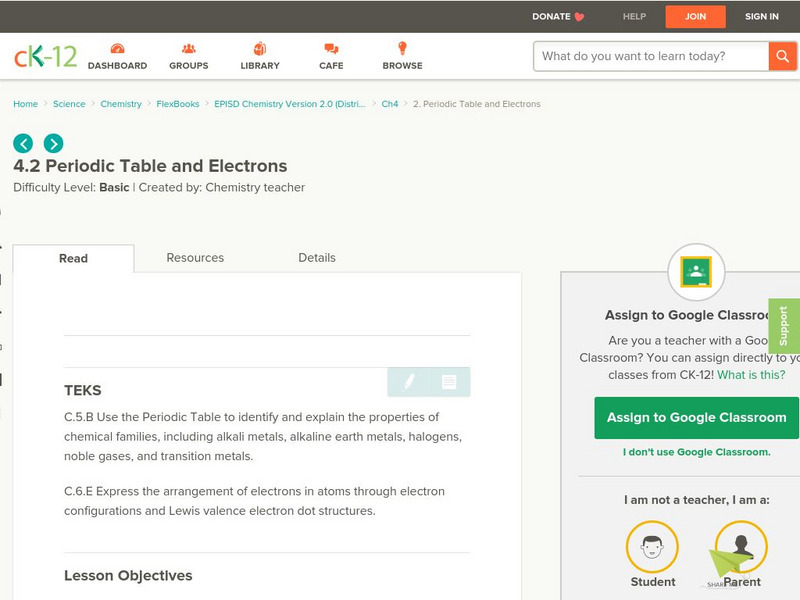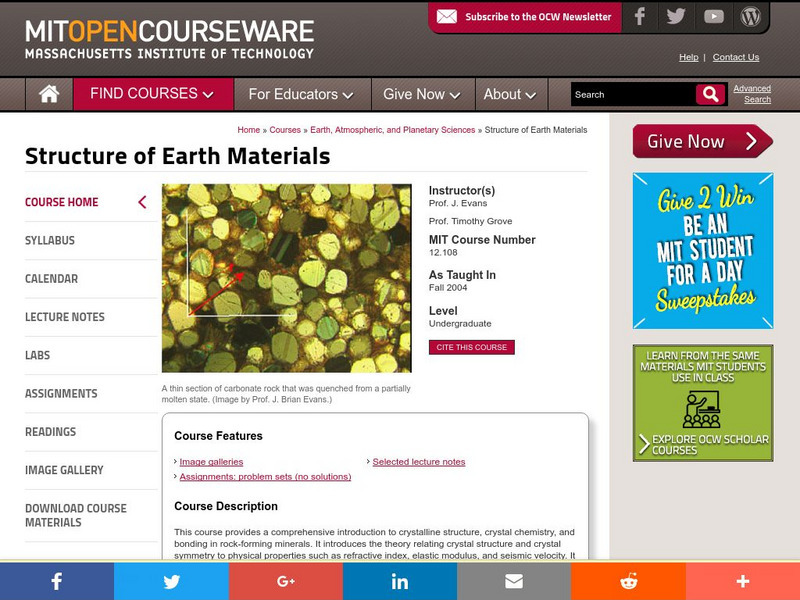Chem4kids
Chem4 Kids: Alkali Metals to the Left
To the left. To the left. The elements in the left column of the period table are alkali metals with the exception of hydrogen. This is a brief overview of the alkali metals, what their family is all about and how well they bond or do...
University of Southern California
Atomic Bonds
This slide show on atomic bonds contains several slides on electron affinity. Other topics include covalent, Sigma and Pi bonds, and atomic bonding in solids.
BBC
Bbc: Gcse Bitesize: Bonding: Covalent Bonds
This section of the lesson module focuses on covalent bonds, which are formed between non-metal atoms that share a pair of electrons. It includes links to a video and a test. Other types of chemical bonds are covered elsewhere in the...
PBS
Pbs Learning Media: Ionic Bonding
A tutorial illustrating ionic bonding. Tutorial explains how and why it occurs with animations and some interactive activities throughout. Explore the bond that forms between sodium and chlorine as you count the number of atoms present.
Chiral Publishing
Chiral Publishing: An Introduction to Chemistry: Molecular Structures: Metals
Ever wondered what the molecular structures of common metals really look like? With this three-dimensional animation, see all of the bonds within the molecules from all directions.
Chemistry Collective
Chem Collective: Metal Ligand Binding
Use silver chloride to determine the binding constant for a metal ligand complex.
Other
Beautiful Chemistry: Beautiful Structures: Metal Organic Frameworks
Interact with these virtual structures of metal-organic frameworks. These special kinds of crystals are made of organic molecules and metal-containing units, which are linked together by chemical bonds.
BBC
Bbc: Gcse Bitesize: Covalent Bonds
A covalent bond is formed between non metal atoms, which combine together by sharing electrons. Covalent compounds have no free electrons and no ions so they don't conduct electricity.
CK-12 Foundation
Ck 12: Electron Configuration and the Periodic Table
[Free Registration/Login may be required to access all resource tools.] In the following online tutorial students will sse the Periodic Table to identify and explain the properties of chemical families, including alkali metals, alkaline...
Science Education Resource Center at Carleton College
Serc: Floating Metal Pins Discrepant Event/guided Inquiry on Surface Tension
Through a combination of an interactive demonstration and guided inquiry, students learn the basic nature of surface tension in liquids.
Other
The Organometallic Hyper Text Book: Alkene Complexes
A summary of alkene complexes formed with transition metals. Includes information on hybridization and synthesis.
Other
The Organometallic Hyper Text Book: Olefin Metathesis
Rearrangements of alkene with transition metal complexes. Includes information on catalysts, mechanisms and other similar polymerizations.
Other
The Organometallic Hyper Text Book: Alkyne Complexes
A detailed discussion of the formation, bonding, and reactivity of alkyne complexes with transition metals. Includes spectroscopic data.
Massachusetts Institute of Technology
Mit: Open Course Ware: Structure of Earth Materials
A college course featuring mineral image galleries, labs, and instructor's notes on the topics of crystalline structure, crystal chemistry, and bonding in rock-forming minerals.
CK-12 Foundation
Ck 12: Chemistry for High School
This digital textbook covers core chemistry concepts and includes interactive features, real-world examples, and videos.
Clackamas Community College
Clackamas Community College: Chemical Bonding: Metals and Nonmetals
A chart of the periodic table of elements, including showing the nonmetal group.
University of Waterloo (Canada)
University of Waterloo: Ionic Compounds
Discussion of ionic compounds includes monatomic and polyatomic ions, lattice energy calculations, and practice questions.
Curated OER
Bonding in Alkenes
A summary of alkene complexes formed with transition metals. Includes information on hybridization and synthesis.
Chem4kids
Chem4 Kids: Magnesium (Mg)
Here you can find some great information about the 12th element in the periodic table, "magnesium." Content focuses on magnesium's electrons, where you can find magnesium in nature and in the home, and how magnesium combines with other...
Davidson College
Davidson College: Network Solids: Crystalline Solids
Explains the differences between ionic, molecular, metallic, and network crystalline solids. Displays structures for diamond, graphite, fullerene, and silica, accompanied by questions about their chemical bonding. Electron density plots...















